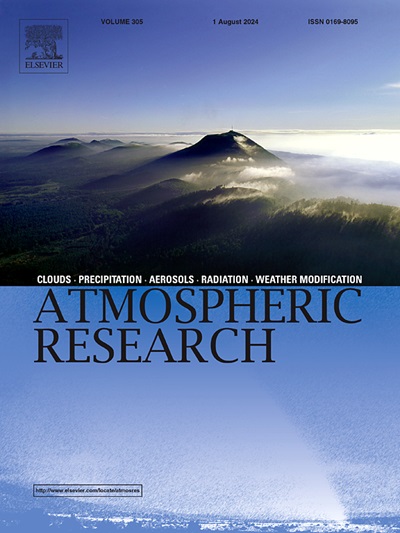The effects of aerosol on the growth of hydrometeors in deep convective clouds
IF 4.5
2区 地球科学
Q1 METEOROLOGY & ATMOSPHERIC SCIENCES
引用次数: 0
Abstract
The impact of aerosol on the development of deep convective clouds and the growth of hydrometeors was investigated using the Weather Research and Forecasting model with a detailed spectral bin microphysics scheme. The simulated cloud top temperature, the vertical profile of moving speed of hydrometeors, and the spatial distributions of precipitation rate were compared with observations from satellite, cloud radar, and weather stations, respectively. The results show that the smaller cloud droplets in the polluted condition have greater mobility with ambient air, which can reach up to 10 km of altitude comparing with 7 km in clean condition, thereby increase the collecting efficiency between ice crystals and supercooled liquid droplets therein. Moreover, ice crystals move slowly around 8 km, thereby facilitating the riming of ice particles by supercooled water to form hailstones. The efficient upward transport of cloud droplets in the convective core area further amplifies this process. Increased aerosol concentration enhances the hail production rate by 2 to 3 orders of magnitude, and results in a 3.48 % increase in effective terminal velocity of hailstone from surface to 4.5 km. The aerosol-induced hail growth effect is stronger over convective cores than that over non-core area. The intensified sedimentation of hail and its accompanying melting in strong downdraft regions contribute to the increased surface precipitation at late stage of convection in polluted condition.
气溶胶对深层对流云中水成物生长的影响
采用详细谱仓微物理方案的天气研究与预报模式,研究了气溶胶对深层对流云发展和水成物生长的影响。将模拟云顶温度、水成物移动速度垂直廓线和降水率空间分布分别与卫星、云雷达和气象站观测结果进行比较。结果表明,污染条件下较小的云滴在周围空气中具有更大的流动性,与清洁条件下的7 km相比,污染条件下的云滴可以达到10 km的高度,从而提高了冰晶与其中的过冷液滴之间的收集效率。此外,冰晶在8公里左右缓慢移动,从而促进了冰粒子被过冷水包围而形成冰雹。对流核心区云滴的高效向上输送进一步放大了这一过程。气溶胶浓度的增加使冰雹的产生率提高了2 ~ 3个数量级,使冰雹从地面到4.5 km的有效终端速度增加了3.48%。气溶胶诱导的冰雹生长效应在对流核区强于在非核区。强下沉气流区冰雹沉降加剧及其伴随的融化是污染条件下对流后期地表降水增加的原因。
本文章由计算机程序翻译,如有差异,请以英文原文为准。
求助全文
约1分钟内获得全文
求助全文
来源期刊

Atmospheric Research
地学-气象与大气科学
CiteScore
9.40
自引率
10.90%
发文量
460
审稿时长
47 days
期刊介绍:
The journal publishes scientific papers (research papers, review articles, letters and notes) dealing with the part of the atmosphere where meteorological events occur. Attention is given to all processes extending from the earth surface to the tropopause, but special emphasis continues to be devoted to the physics of clouds, mesoscale meteorology and air pollution, i.e. atmospheric aerosols; microphysical processes; cloud dynamics and thermodynamics; numerical simulation, climatology, climate change and weather modification.
 求助内容:
求助内容: 应助结果提醒方式:
应助结果提醒方式:


